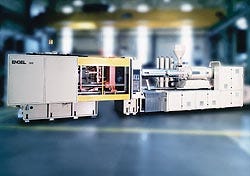May 23, 2001
|
Matching a molding machine to the jobs you will run is a key in the selection process. |
Sometimes you go to purchase a molding machine for a specific job; sometimes you are looking for a machine to give you additional capacity for future parts, exact size and configuration unknown. Probably one of the most difficult aspects of purchasing a molding machine, particularly if it is not for a specific job, is ensuring that the quotes you solicit from different machinery manufacturers are comparable. Therefore, the more preparation done ahead of the request for quotation, the better the chance that the quotes will be comparable. Also, it is useful to explain the reasons behind certain unusual specifications so that you can be sure the machine you buy will meet your needs.
One good place to start is looking at any deficiencies of your existing equipment, in terms of performance, maintenance costs, downtime, or supplier service. Let's assume you know the application that's going to run in the machine. The next critical step is to get accurate data on the tool and the part. The mold's outside dimensions will affect the size of the machine's platens, and the projected area of the part (in square inches) determines the injection pressure and the size of the injection unit required. If you're planning to run several molds in the machine, make a spreadsheet that includes all the molds, and then use the largest dimension for each mold, except for wall thickness. For that, use the part wall thickness with the smallest measurement as your guide. These are the dimensions you will need:
When to add capacity |
|
Mold width.
Mold length.
Mold stack height.
Mold opening distance.
Ejector rod spacing.
Center ring diameter.
Part dimensions.
Part wall thickness.
Part flow length.
Part weight.
Runner weight.
Number of parts.
Total shot weight.
Nozzle radius.
Material (and its viscosity).
If it's a multicavity mold, multiply the individual part dimensions by the number of cavities, or total all parts if they are not the same. However, if you are using a stack mold, you need to multiply part surface area by only 1.4 to get the total projected area. Also, remember that if you are planning on robotic ejection, allow for space for the robot to enter the mold and retract the parts in figuring your total daylight.
With these measurements, you or your supplier can analyze the injection pressure, both in the barrel and in the cavity, and the injection unit size required. The next step is to determine the clamp tonnage, based on defined injection pressure, projected area, and theoretical injection pressure. Once you've determined the clamping pressure, double-check that your mold will fit the tiebar spacing and that the opening stroke will allow your mold to open fully and get the part removed.
Rules of Thumb |
|
The last step is to figure out which options are needed. One kind is required to produce and handle the parts. For example, what extra hydraulic functions will you need (such as core pulls, valve gates, inmold ejectors)? What air functions are required (valve gates, part blowoffs, core air, cavity air)? What about extra control functions? Will you need a robot or other auxiliary equipment interface, valve gate sequence control, mold heaters (electric or hot oil), nozzle shutoff, leveling pads, a special screw and barrel, and so forth? Other options are those that would be useful in improving machine operations, such as graphical operator interface, SPC/ SQC charts, quality control computer interface, or production monitoring interfaces (data logging, card readers, printers, cycle analysis, and so forth).
If you are currently molding this part, pass the appropriate information (current machine specs and any deficiencies you want to overcome) along to your prospective suppliers.
When quotes are returned, compare them on as equal a basis as possible. Evaluate each vendor's capabilities by looking at how the machines are built, if you can. Check out the machine's performance. Review the machine manuals, and ask how urgent spare parts orders are handled. Find out who provides customer training and telephone diagnostic assistance. Check supplier references.
Machine cost calculations | ||||||||||||||||||||||||||||||||||||||||
|
Finally, don't forget to ask about rigging or setup costs. What will shipping charges be? Do you need CE certification on the machine? Any other engineering? If you communicate your objectives clearly to your potential supplier, you should end up with a comparable quotation. When the comparison of the less concrete attributes are completed, you should have your new supplier.
With our thanks . . .
. . . to the following machine suppliers, who helped with material that contributed to this article: Husky, Krauss-Maffei, Niigata, and Wabash.
Go to the IMM Almanac Online home page.
You May Also Like



